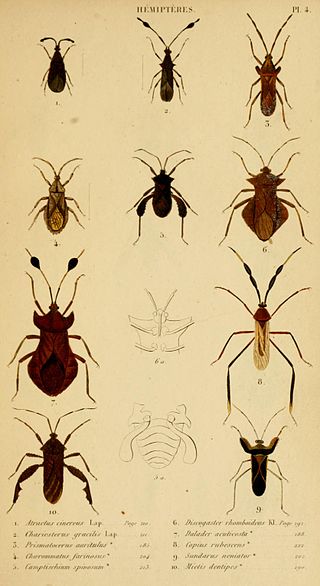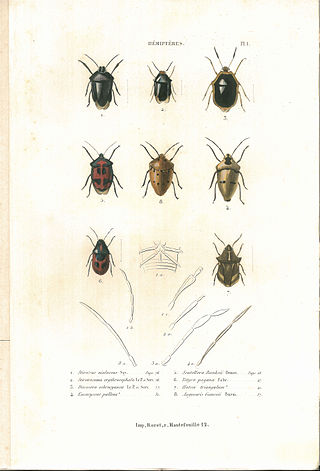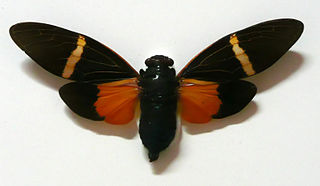
Charles Jean-Baptiste Amyot was a French lawyer and entomologist especially interested in the Hemiptera.

Jean Guillaume Audinet-Serville was a French entomologist, born on 11 November 1775 in Paris. He died on 27 March 1858 in La Ferté-sous-Jouarre.

The Lygaeoidea are a sizeable superfamily of true bugs, containing seed bugs and allies, in the order Hemiptera. There are about 16 families and more than 4,600 described species in Lygaeoidea, found worldwide. Most feed on seeds or sap, but a few are predators.

Les Suites à Buffon is a French 19th-century scientific publication.

The Harpactorinae are a large subfamily of the Reduviidae. About 300 genera and 2,000 species worldwide have been described. Some of the species of the genera Zelus, Pselliopus, Sinea, and Apiomerus are of interest as biological pest control agents.

Tosena is a genus of cicadas from South-East Asia. They are the type genus of tribe Tosenini. Species formerly included in Tosena are Distantalna splendida, Formotosena montivaga, Formotosena seebohmi and Trengganua sibylla.

Flatidae are a family of fulgoroid planthoppers. They are cosmopolitan in distribution and are distinguished from others in the superfamily by a combination of characters. Like all other planthoppers, they suck phloem sap of plants. Some species are known to communicate with vibrations through the plant stems. Communication may be with mates, or with ants that tend the nymphs, protecting them and gathering honeydew secretions. Adults of some species have brightly coloured forewings which are tougher and known as tegmina unlike the membranous hindwings which are used for flight. Although a few can be identified by their coloration, most species requires dissection and examination under a microscope with access to literature on already described species.

The Platypleurini are a tribe of cicadas from the Afrotropical and Oriental regions There are at least 30 genera and 240 described species in Platypleurini.

Nezara is a genus of plant-feeding stink bug of the family Pentatomidae, first described by Charles Jean-Baptiste Amyot & Jean Guillaume Audinet-Serville in 1843.

Zicrona is a genus of bugs of the family Pentatomidae. It was circumscribed by Charles Jean-Baptiste Amyot and Jean Guillaume Audinet-Serville

Cydninae is a subfamily of burrowing bugs in the family Cydnidae. There are about 11 genera and at least 40 described species in Cydninae.

Stegaspidinae is a subfamily of treehoppers in the family Membracidae.

Membracinae is a subfamily of treehoppers in the family Membracidae. There are more than 40 genera in Membracinae.

Acanaloniidae is a family of planthoppers. It is sometimes treated as a subfamily of Issidae.

Pochazia is a genus of true bugs belonging to the family Ricaniidae.
Smilia fasciata is a species of treehopper belonging to the family Membracidae. It was first described by Charles Jean-Baptiste Amyot and Jean Guillaume Audinet-Serville in 1843.

Darninae is a subfamily of treehoppers belonging to the family Membracidae. It includes 5 tribes and about 30 genera.

Eucorysses is a genus of Asian jewel or shield-backed bugs in the tribe Scutellerini, erected by Amyot & Audinet-Serville in 1843. Records of occurrence are from India through southern China to Japan, Indochina and western Malesia.
















